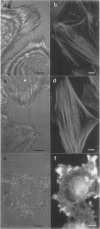Abstract
Fibronectin has been shown previously to promote complete cell adhesion in the absence of other serum components or de novo protein synthesis. Recently a sequence of four amino acids from the cell-binding domain of fibronectin has been termed the 'cell recognition site' of this multidomain molecule since it mediates cell attachment and inhibits cell adhesion to intact fibronectin. We show here, however, that substrata coated with an isolated cell-binding domain of fibronectin are not sufficient for complete cell adhesion; cells attach and spread but, unlike those adhering to intact fibronectin, they do not form stress fibres terminating in focal adhesions. An additional external stimulus is needed for this cytoskeletal reorganisation and may be provided by one of two heparin-binding fragments of fibronectin. The two 'signals' required for complete adhesion need not be provided simultaneously since focal adhesion formation can be promoted by stimulating cells pre-spread on a cell-binding fragment of fibronectin with a soluble heparin-binding fragment. This second stimulation may involve cell membrane heparan sulphate proteoglycans.
Full text
PDF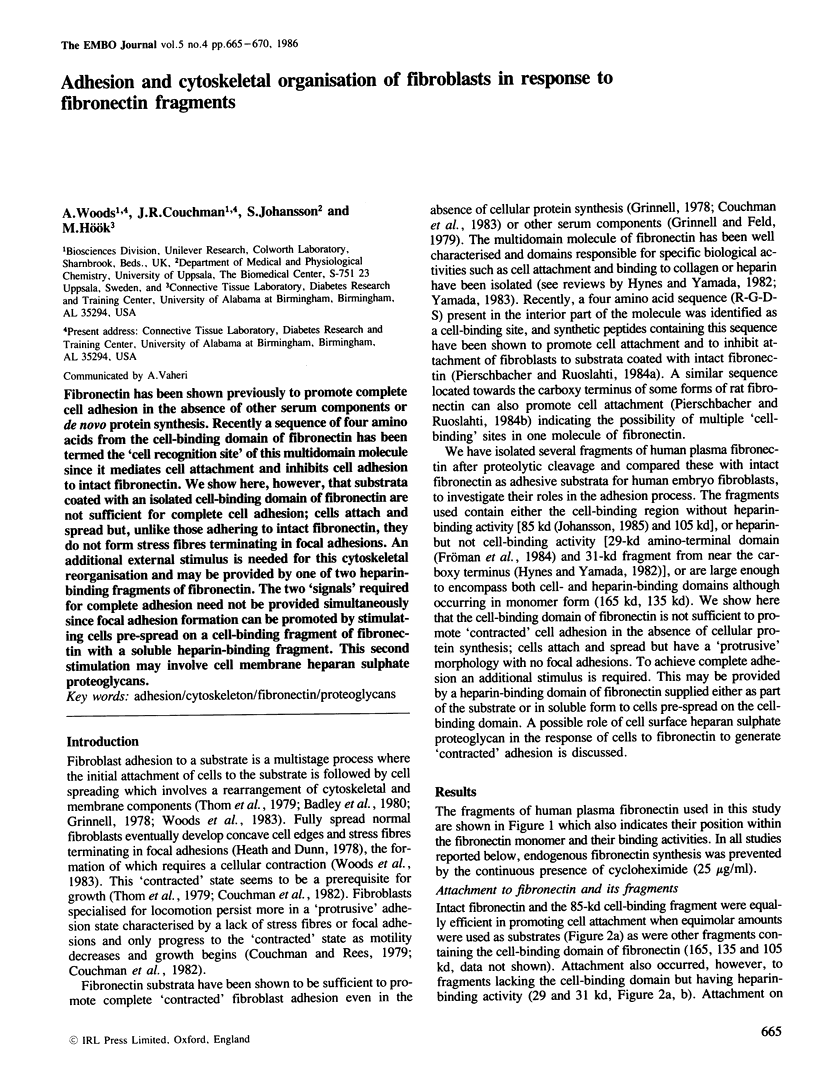
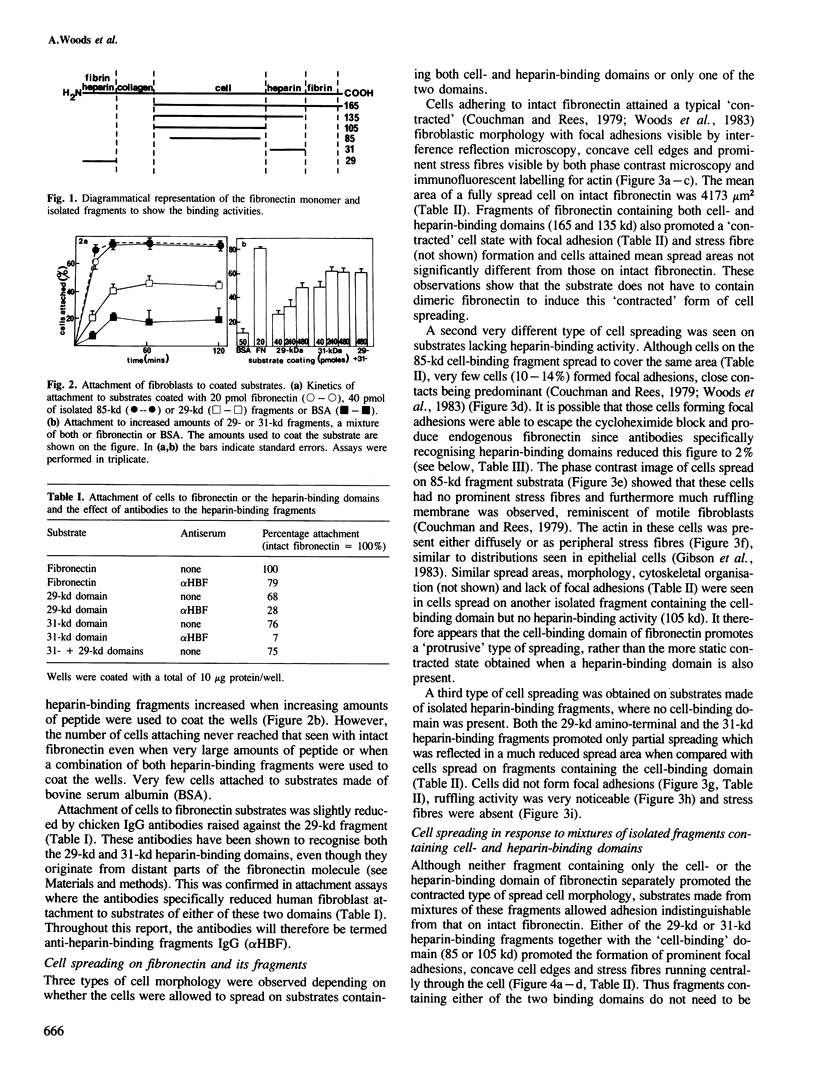
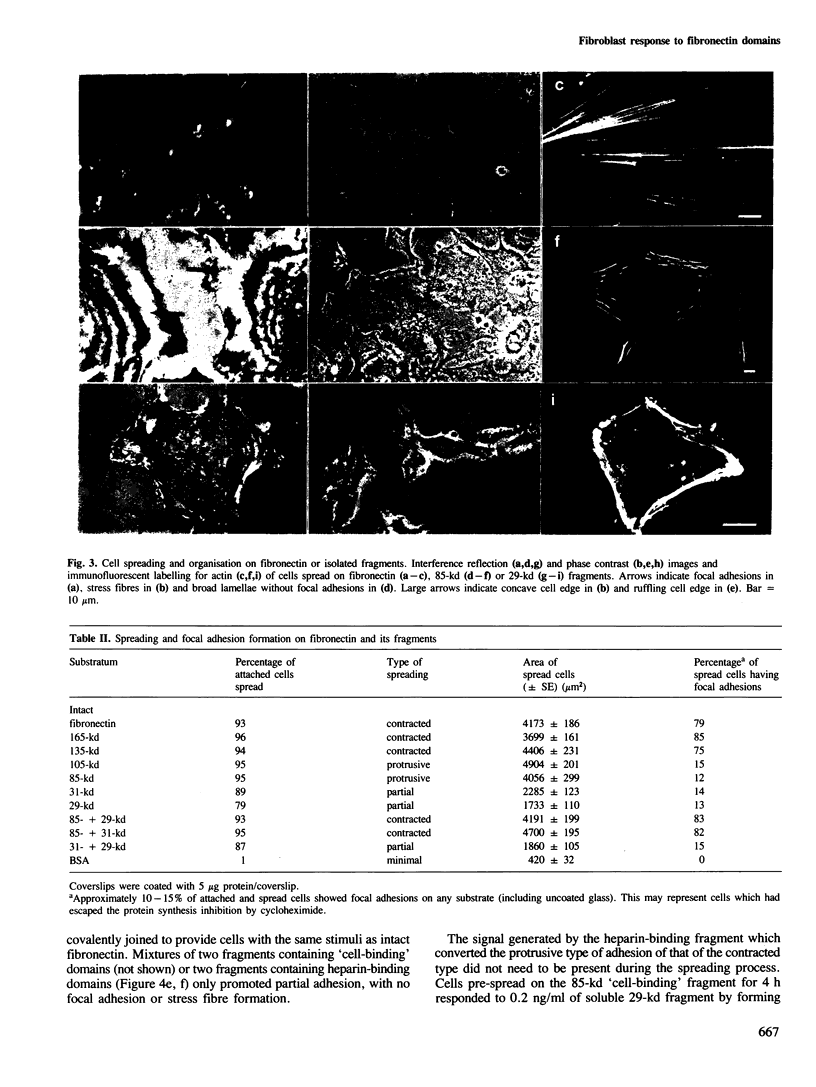
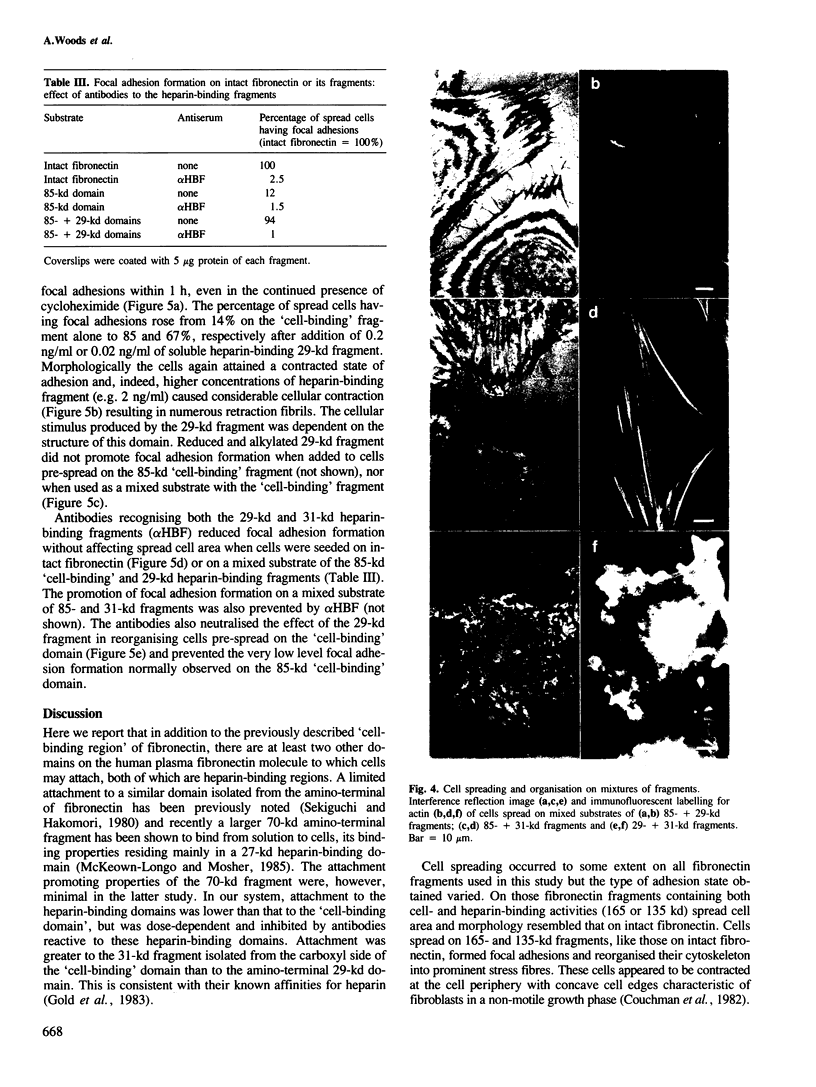
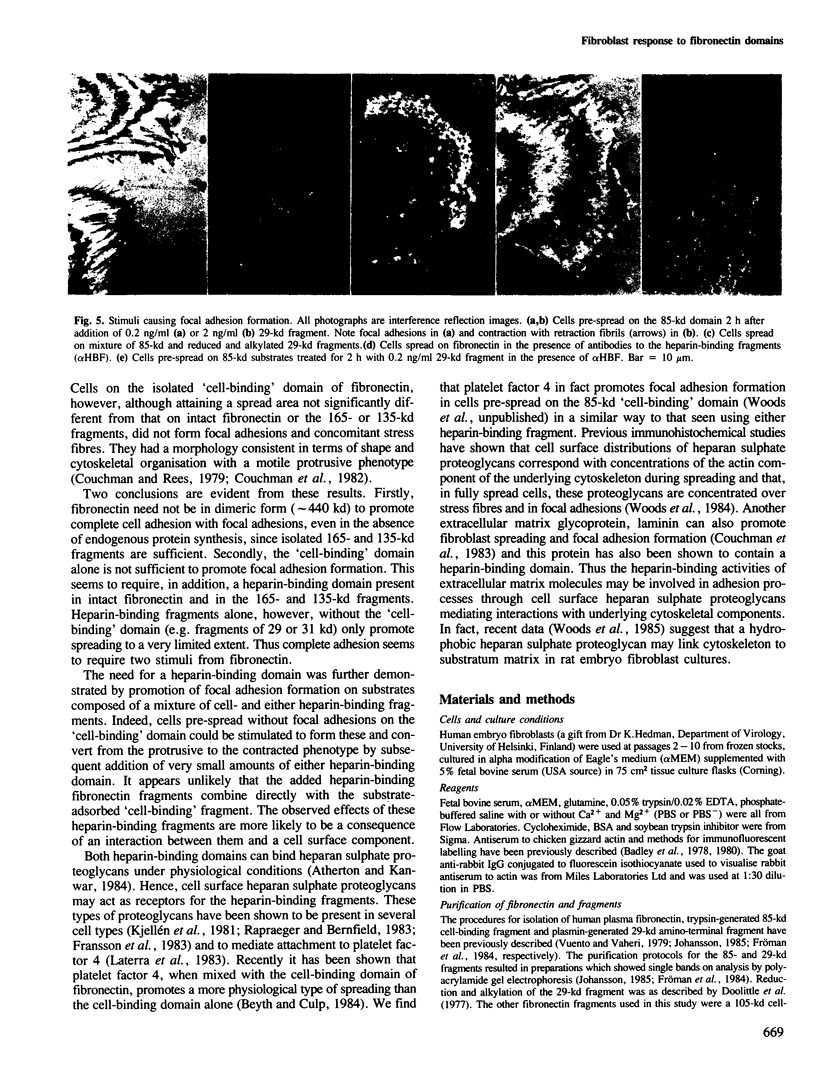
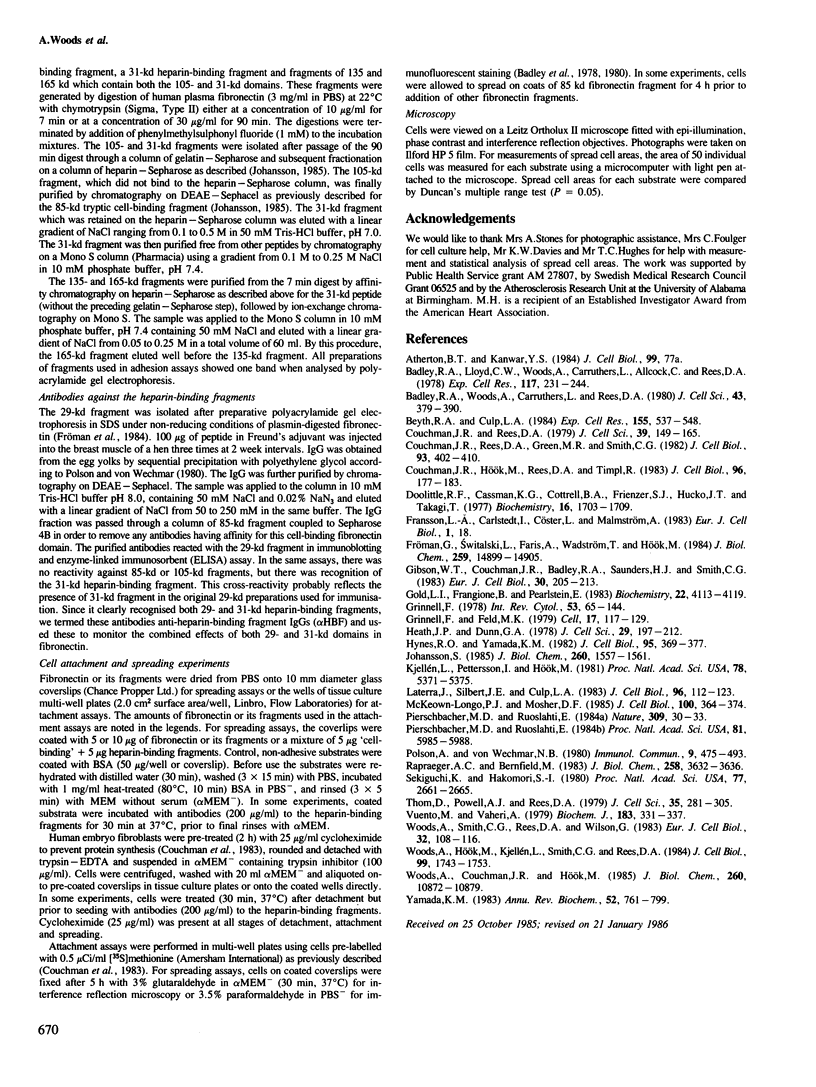
Images in this article
Selected References
These references are in PubMed. This may not be the complete list of references from this article.
- Badley R. A., Lloyd C. W., Woods A., Carruthers L., Allcock C., Rees D. A. Mechanisms of cellular adhesion. III. Preparation and preliminary characterisation of adhesions. Exp Cell Res. 1978 Dec;117(2):231–244. doi: 10.1016/0014-4827(78)90136-2. [DOI] [PubMed] [Google Scholar]
- Badley R. A., Woods A., Carruthers L., Rees D. A. Cytoskeleton changes in fibroblast adhesion and detachment. J Cell Sci. 1980 Jun;43:379–390. doi: 10.1242/jcs.43.1.379. [DOI] [PubMed] [Google Scholar]
- Beyth R. J., Culp L. A. Complementary adhesive responses of human skin fibroblasts to the cell-binding domain of fibronectin and the heparan sulfate-binding protein, platelet factor-4. Exp Cell Res. 1984 Dec;155(2):537–548. doi: 10.1016/0014-4827(84)90213-1. [DOI] [PubMed] [Google Scholar]
- Couchman J. R., Hök M., Rees D. A., Timpl R. Adhesion, growth, and matrix production by fibroblasts on laminin substrates. J Cell Biol. 1983 Jan;96(1):177–183. doi: 10.1083/jcb.96.1.177. [DOI] [PMC free article] [PubMed] [Google Scholar]
- Couchman J. R., Rees D. A., Green M. R., Smith C. G. Fibronectin has a dual role in locomotion and anchorage of primary chick fibroblasts and can promote entry into the division cycle. J Cell Biol. 1982 May;93(2):402–410. doi: 10.1083/jcb.93.2.402. [DOI] [PMC free article] [PubMed] [Google Scholar]
- Couchman J. R., Rees D. A. The behaviour of fibroblasts migrating from chick heart explants: changes in adhesion, locomotion and growth, and in the distribution of actomyosin and fibronectin. J Cell Sci. 1979 Oct;39:149–165. doi: 10.1242/jcs.39.1.149. [DOI] [PubMed] [Google Scholar]
- Doolittle R. F., Cassman K. G., Cottrell B. A., Friezner S. J., Hucko J. T., Takagi T. Amino acid sequence studies on the alpha chain of human fibrinogen. Characterization of 11 cyanogen bromide fragments. Biochemistry. 1977 Apr 19;16(8):1703–1709. doi: 10.1021/bi00627a028. [DOI] [PubMed] [Google Scholar]
- Fröman G., Switalski L. M., Faris A., Wadström T., Hök M. Binding of Escherichia coli to fibronectin. A mechanism of tissue adherence. J Biol Chem. 1984 Dec 10;259(23):14899–14905. [PubMed] [Google Scholar]
- Gibson W. T., Couchman J. R., Badley R. A., Saunders H. J., Smith C. G. Fibronectin in cultured rat keratinocytes: distribution, synthesis, and relationship to cytoskeletal proteins. Eur J Cell Biol. 1983 May;30(2):205–213. [PubMed] [Google Scholar]
- Gold L. I., Frangione B., Pearlstein E. Biochemical and immunological characterization of three binding sites on human plasma fibronectin with different affinities for heparin. Biochemistry. 1983 Aug 16;22(17):4113–4119. doi: 10.1021/bi00286a019. [DOI] [PubMed] [Google Scholar]
- Grinnell F. Cellular adhesiveness and extracellular substrata. Int Rev Cytol. 1978;53:65–144. doi: 10.1016/s0074-7696(08)62241-x. [DOI] [PubMed] [Google Scholar]
- Grinnell F., Feld M. K. Initial adhesion of human fibroblasts in serum-free medium: possible role of secreted fibronectin. Cell. 1979 May;17(1):117–129. doi: 10.1016/0092-8674(79)90300-3. [DOI] [PubMed] [Google Scholar]
- Heath J. P., Dunn G. A. Cell to substratum contacts of chick fibroblasts and their relation to the microfilament system. A correlated interference-reflexion and high-voltage electron-microscope study. J Cell Sci. 1978 Feb;29:197–212. doi: 10.1242/jcs.29.1.197. [DOI] [PubMed] [Google Scholar]
- Hynes R. O., Yamada K. M. Fibronectins: multifunctional modular glycoproteins. J Cell Biol. 1982 Nov;95(2 Pt 1):369–377. doi: 10.1083/jcb.95.2.369. [DOI] [PMC free article] [PubMed] [Google Scholar]
- Johansson S. Demonstration of high affinity fibronectin receptors on rat hepatocytes in suspension. J Biol Chem. 1985 Feb 10;260(3):1557–1561. [PubMed] [Google Scholar]
- Kjellén L., Pettersson I., Hök M. Cell-surface heparan sulfate: an intercalated membrane proteoglycan. Proc Natl Acad Sci U S A. 1981 Sep;78(9):5371–5375. doi: 10.1073/pnas.78.9.5371. [DOI] [PMC free article] [PubMed] [Google Scholar]
- Laterra J., Silbert J. E., Culp L. A. Cell surface heparan sulfate mediates some adhesive responses to glycosaminoglycan-binding matrices, including fibronectin. J Cell Biol. 1983 Jan;96(1):112–123. doi: 10.1083/jcb.96.1.112. [DOI] [PMC free article] [PubMed] [Google Scholar]
- McKeown-Longo P. J., Mosher D. F. Interaction of the 70,000-mol-wt amino-terminal fragment of fibronectin with the matrix-assembly receptor of fibroblasts. J Cell Biol. 1985 Feb;100(2):364–374. doi: 10.1083/jcb.100.2.364. [DOI] [PMC free article] [PubMed] [Google Scholar]
- Pierschbacher M. D., Ruoslahti E. Cell attachment activity of fibronectin can be duplicated by small synthetic fragments of the molecule. Nature. 1984 May 3;309(5963):30–33. doi: 10.1038/309030a0. [DOI] [PubMed] [Google Scholar]
- Pierschbacher M. D., Ruoslahti E. Variants of the cell recognition site of fibronectin that retain attachment-promoting activity. Proc Natl Acad Sci U S A. 1984 Oct;81(19):5985–5988. doi: 10.1073/pnas.81.19.5985. [DOI] [PMC free article] [PubMed] [Google Scholar]
- Polson A., von Wechmar M. B., van Regenmortel M. H. Isolation of viral IgY antibodies from yolks of immunized hens. Immunol Commun. 1980;9(5):475–493. doi: 10.3109/08820138009066010. [DOI] [PubMed] [Google Scholar]
- Rapraeger A. C., Bernfield M. Heparan sulfate proteoglycans from mouse mammary epithelial cells. A putative membrane proteoglycan associates quantitatively with lipid vesicles. J Biol Chem. 1983 Mar 25;258(6):3632–3636. [PubMed] [Google Scholar]
- Sekiguchi K., Hakomori S. Functional domain structure of fibronectin. Proc Natl Acad Sci U S A. 1980 May;77(5):2661–2665. doi: 10.1073/pnas.77.5.2661. [DOI] [PMC free article] [PubMed] [Google Scholar]
- Thom D., Powell A. J., Rees D. A. Mechanisms of cellular adhesion. IV. Role of serum glycoproteins in fibroblast spreading on glass. J Cell Sci. 1979 Feb;35:281–305. doi: 10.1242/jcs.35.1.281. [DOI] [PubMed] [Google Scholar]
- Vuento M., Vaheri A. Purification of fibronectin from human plasma by affinity chromatography under non-denaturing conditions. Biochem J. 1979 Nov 1;183(2):331–337. doi: 10.1042/bj1830331. [DOI] [PMC free article] [PubMed] [Google Scholar]
- Woods A., Couchman J. R., Hök M. Heparan sulfate proteoglycans of rat embryo fibroblasts. A hydrophobic form may link cytoskeleton and matrix components. J Biol Chem. 1985 Sep 5;260(19):10872–10879. [PubMed] [Google Scholar]
- Woods A., Hök M., Kjellén L., Smith C. G., Rees D. A. Relationship of heparan sulfate proteoglycans to the cytoskeleton and extracellular matrix of cultured fibroblasts. J Cell Biol. 1984 Nov;99(5):1743–1753. doi: 10.1083/jcb.99.5.1743. [DOI] [PMC free article] [PubMed] [Google Scholar]
- Woods A., Smith C. G., Rees D. A., Wilson G. Stages in specialization of fibroblast adhesion and deposition of extracellular matrix. Eur J Cell Biol. 1983 Nov;32(1):108–116. [PubMed] [Google Scholar]
- Yamada K. M. Cell surface interactions with extracellular materials. Annu Rev Biochem. 1983;52:761–799. doi: 10.1146/annurev.bi.52.070183.003553. [DOI] [PubMed] [Google Scholar]




